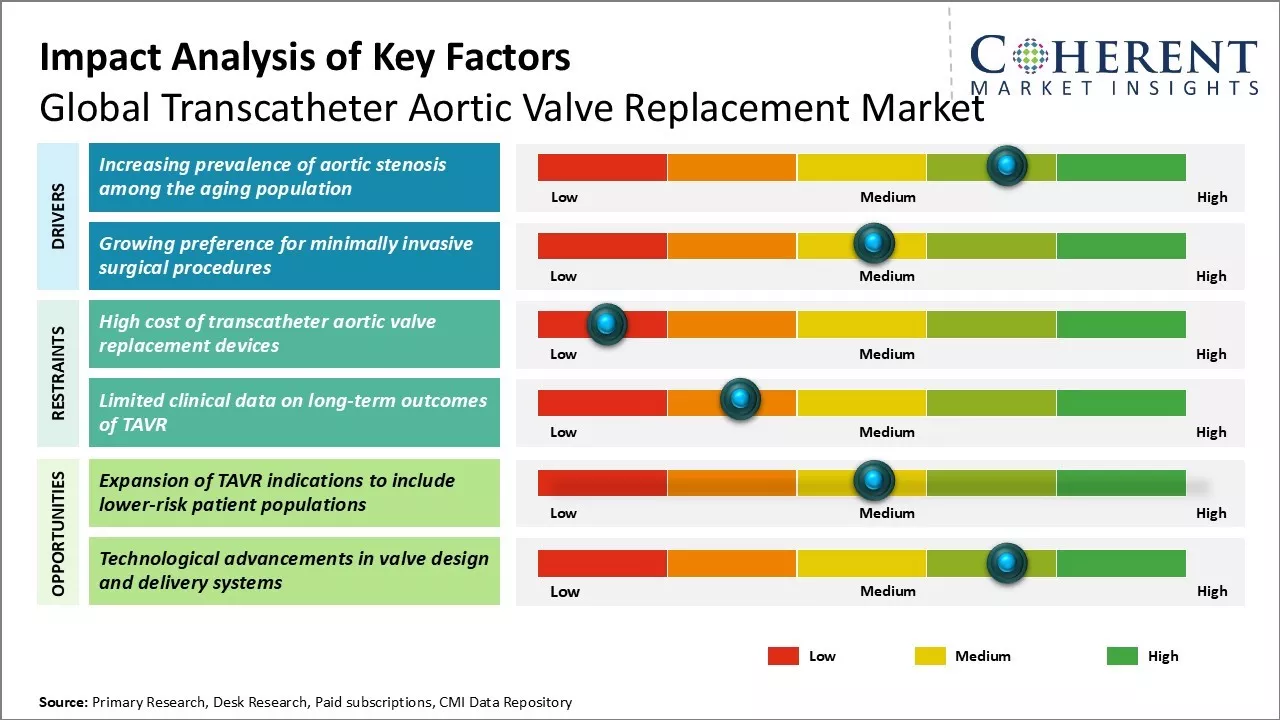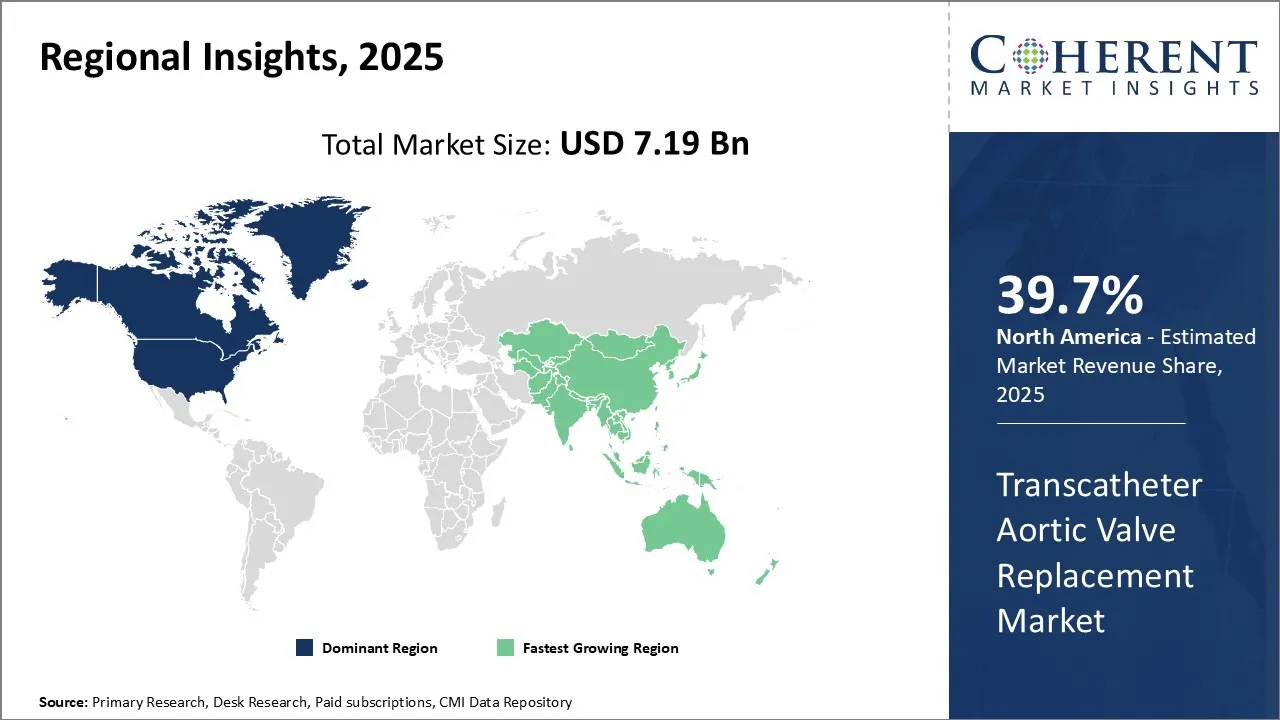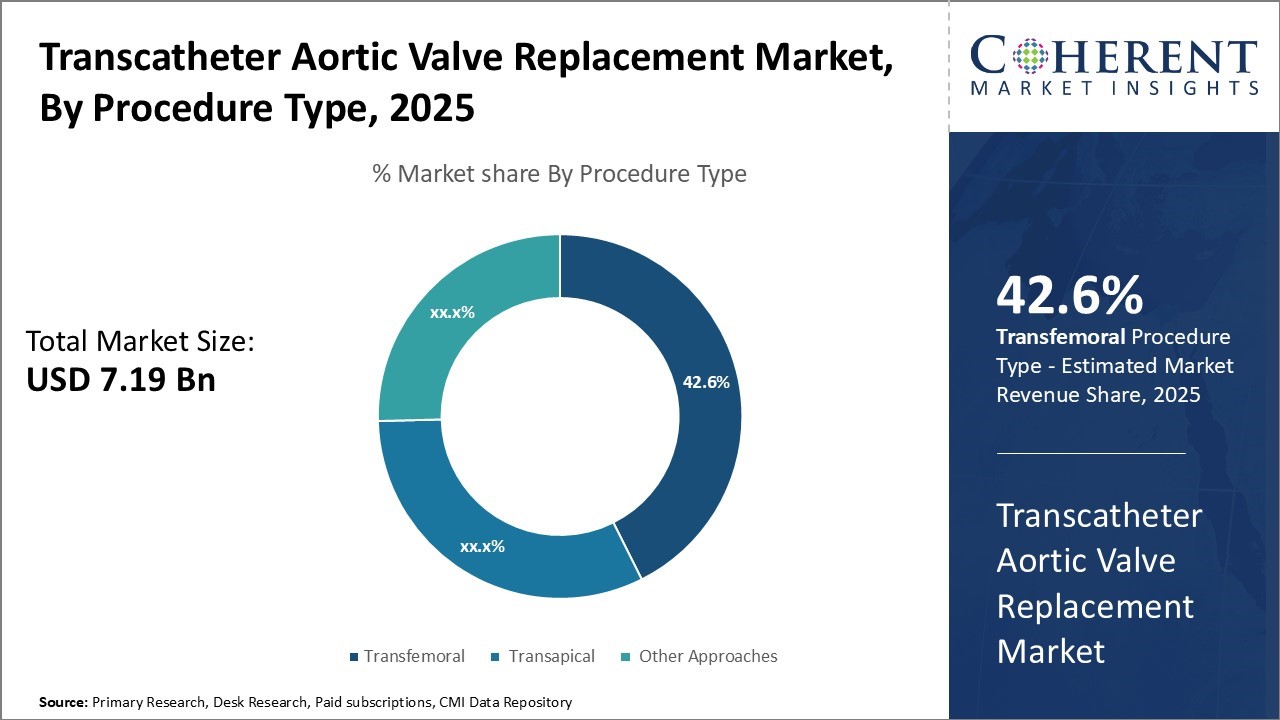Transcatheter Aortic Valve Replacement Market Size and Trends
The global transcatheter aortic valve replacement market is estimated to be valued at USD 7.19 Bn in 2025 and is expected to reach USD 11.71 Bn by 2032, exhibiting a compound annual growth rate (CAGR) of 7% from 2025 to 2032.

To learn more about this report, Download Free Sample
Key Takeaways
- Based on Procedure Type, Transfemoral segment is projected to account for 42.6% of the global market in 2025, owing to its minimally invasive nature and faster recovery times compared to traditional surgical methods.
- Based on Device Type, Balloon-Expandable Valves segment is expected to capture 52% share of the market in 2025, due to their quicker implantation and track record of positive clinical outcomes.
- By End User Insight, Hospitals are projected to account 38.7% share in 2025, due to state-of-the-art infrastructure and multidisciplinary teams.
- Based on Region, North America is set to dominate the global market with a 39.7% share in 2025.
Market Overview
The growing geriatric population with aortic stenosis and increasing preference for minimally invasive surgeries are key drivers for the transcatheter aortic valve replacement market growth. Additionally, the market for transcatheter aortic valve replacement is expected to witness a significant growth due to the rising prevalence of aortic stenosis and increasing number of transcatheter aortic valve replacement procedures performed worldwide.
Current Events and their Impact on the Transcatheter Aortic Valve Replacement Market
|
Current Event |
Description and its Impact |
|
Aging Population Demographics and Healthcare System Strain |
|
|
Regulatory Evolution and Clinical Guidelines Updates |
|
Uncover macros and micros vetted on 75+ parameters: Get instant access to report
Transcatheter Aortic Valve Replacement Reimbursement Scenario
Transcatheter Aortic Valve Replacement (TAVR) is covered by CMS under Coverage with Evidence Development (CED) for patients with symptomatic aortic stenosis, when performed using an FDA-approved device and the following conditions are met:
- The patient is evaluated and managed by a qualified heart team, including a cardiac surgeon and an interventional cardiologist, both of whom:
- Perform face-to-face assessments.
- Document treatment suitability.
- Jointly participate in the procedure.
- The procedure is performed at a hospital with:
- On-site cardiac surgery and interventional cardiology programs.
- Adequate ICU support.
- Required procedural volume and experienced staff.
- The hospital participates in a national, audited registry that:
- Tracks outcomes (e.g., mortality, stroke, quality of life).
- Follows patients for ≥1 year.
- Complies with all human research protection regulations.
For non-FDA-approved indications, TAVR is covered only when conducted under a CMS-approved clinical study that meets strict scientific and ethical standards, includes informed consent, and publicly reports results.
Transcatheter Aortic Valve Replacement Market Insights, By Procedure Type - The Rise of Transfemoral Procedures in Aortic Valve Treatment
In terms of procedure type, the transfemoral segment is expected to contribute the highest market share of 42.6% in 2025 due to its minimally invasive nature and faster recovery times compared to traditional surgical methods.
For instance, in September 2022, JenaValve Technology closed a Series C financing round worth USD 100 million. JenaValve is committed to become the first and only FDA-approved transfemoral transcatheter valve system indicated for symptomatic, severe AR, addressing an estimated multi-billion-dollar U.S. market opportunity
Transcatheter Aortic Valve Replacement Market Insights, By Device Type - Balloon-Expandable Valves Lead with Positive Clinical Outcomes
In terms of device type, balloon-expandable valves segment is expected to contribute the highest market share of 52% in 2025 owing to their quicker implantation and track record of positive clinical outcomes. These valves are compressed and delivered to the target location through a catheter before being expanded to their functioning size with a balloon.
For instance, in November 2024, Abbott announced the first patient procedures with its investigational transcatheter aortic valve implantation (TAVI) balloon-expandable system. This system is used to treat symptomatic severe aortic stenosis.
Transcatheter Aortic Valve Replacement Market Insights, By End User - Hospitals Remain at the Forefront
In terms of end user, hospitals segment is expected to contribute the highest market share of 38.7% in 2025 owing to state-of-the-art infrastructure and multidisciplinary teams. Most transcatheter aortic valve replacement (TAVR) procedures, especially complex cases, are performed in hospitals that have advanced catheterization labs, cardiac surgery backups, intensive care facilities, and round-the-clock specialized staff. The high-acuity nature of many patients along with the delicate nature of the operation require expert management at every step.
For instance, in March 2024, Sierra Medical Center (SMC), the region’s newest hospital, announced the launch of a new procedure for aortic stenosis, Transcatheter Aortic Valve Replacement (TAVR).
Regional Insights

To learn more about this report, Download Free Sample
Dominating Region: North America
North America dominates is estimated to account 39.7% of transcatheter aortic valve replacement market share in 2025. This can be attributed to the strong presence of major medical device manufacturers, supportive reimbursement policies, high adoption rates among the aging population, and continual technological advancements.
For instance, in January 2024, Eisenhower Health became the first hospital in the U.S. to be designated as an Edwards Benchmark Program Case Observation Site for treating aortic stenosis in patients undergoing transcatheter aortic valve replacement.
Fastest-Growing Region: Asia Pacific
The Asia Pacific growth is driven by increasing healthcare expenditures, rapid economic expansion, growing medical tourism, and government efforts to enhance accessibility of critical cardiac procedures. Countries like India and China are key focus areas for leading global companies like Abbott Laboratories looking to tap into untapped market potential.
For instance, in September 2025, Edwards Lifesciences announced the launch of its transcatheter heart valve platform in India for the treatment of aortic stenosis. This advanced therapy is designed to meet the needs of patients who are not candidates for open-heart surgery.
Transcatheter Aortic Valve Replacement Market Outlook for Key countries
High Prevalence of Aortic Regurgitation in the U.S.
The U.S. leads in managing aortic regurgitation due to its high prevalence of the condition of aortic regurgitation (AR). For instance, the article "Aortic Regurgitation," published by StatPearls in April 2022 reported that the prevalence of aortic regurgitation in the U.S. ranges between 5.4% and 10.5%. Additionally, it highlighted that men (13.5%) are more likely to experience aortic regurgitation compared to women (9%).
Clinical Trials Driving Transcatheter Aortic Valve Replacement Adoption in the U.K.
The U.K. transcatheter aortic valve replacement industry is shaped by ongoing research and clinical trials. For example, the UK-TAVI trial, conducted in September 2022 by the National Institutes of Health (NIH), compared the outcomes of TAVR and surgical aortic valve replacement in patients over 70 with moderate operative risk. These trials play a vital role in evaluating safety and efficacy, influencing the integration of TAVR into clinical practice in the U.K.
Innovation in TAVR Technology and Accessibility in China
China’s transcatheter aortic valve replacement industry is experiencing growth driven by advancements in valve technology and procedural techniques. For instance, in January 2022, Medtronic announced that China’s National Medical Products Administration (NMPA) has approved the company’s CoreValve Evolut Pro transcatheter aortic valve replacement (TAVR) system for the treatment of severe
Public Insurance Expanding Access to TAVR Treatments in Brazil
Brazil’s transcatheter aortic valve replacement market is boosted by comprehensive public insurance and efforts to expand access to under-served patient segments. Local medtech firms contribute to this progress.
Market Concentration and Competitive Landscape

To learn more about this report, Download Free Sample
Key Takeaways from Analyst
- The global transcatheter aortic valve replacement market is poised for strong growth, driven by a rising geriatric population and increasing aortic stenosis cases. Asia Pacific (excluding Japan) is expected to see the fastest growth due to improved healthcare infrastructure and medical tourism.
- North America will dominate due to advanced technology and supportive policies. Self-expandable valves are gaining popularity for their lower risk but lack long-term durability data, offering opportunities for innovation.
Transcatheter Aortic Valve Replacement Industry News
- In March 2025, Abbott, announced the launch of Navitor Vision in India for the treatment of patients with symptomatic severe aortic stenosis who are at high or extreme surgical risk.
- In December 2024, SMT announces the launch of its Hydra Transcatheter Aortic Valve Replacement (TAVR) system in Mexico.
- In March 2024, Medtronic plc, announced that the U.S. Food and Drug Administration (FDA) approved the Evolut FX+ transcatheter aortic valve replacement system for treating symptomatic severe aortic stenosis. The new Evolut FX+ TAVR system retains the valve performance benefits of the previous Evolut TAVR platform and is designed to enhance coronary access.
Market Report Scope
Transcatheter Aortic Valve Replacement Market
| Report Coverage | Details | ||
|---|---|---|---|
| Base Year: | 2024 | Market Size in 2025: |
USD 7.19 Bn |
| Historical Data for: | 2020 To 2024 | Forecast Period: | 2025 To 2032 |
| Forecast Period 2025 to 2032 CAGR: | 7.2% | 2032 Value Projection: | USD 11.71 Bn |
| Geographies covered: |
|
||
| Segments covered: |
|
||
| Companies covered: |
Edwards Lifesciences Corp., Medtronic Plc., Abbott Laboratories., Boston Scientific Corp., MicroPort Scientific Corp., JenaValve Technology GmbH., Cardiovascular Systems, Inc., Symetis SA., Lepu Medical Technology Co., Ltd., Terumo Corporation., St. Jude Medical (now part of Abbott)., AtriCure, Inc., Vascular Solutions, Inc., Biotronik SE & Co. KG., and Cook Medical |
||
| Growth Drivers: |
|
||
| Restraints & Challenges: |
|
||
Uncover macros and micros vetted on 75+ parameters: Get instant access to report
Market Dynamics
Market Driver - Increasing prevalence of aortic stenosis among the aging population
The aging global population has led to a rise in age-related conditions like aortic stenosis, a narrowing of the aortic valve that restricts blood flow. Advancements in healthcare have increased life expectancy, contributing to more elderly individuals at risk.
For instance, according to the National Institute of Health, in April 2024, 2-7% of people over the age of 65 may have measurable aortic stenosis. Approximately 13% of people over 75 years of age have mild-to-moderate aortic stenosis while around 4% have severe aortic stenosis requiring surgical treatment.
Market Opportunity - Expansion of TAVR indications to include lower-risk patient populations
The expansion of TAVR indications to include lower-risk patient populations presents a major opportunity for long-term growth of the global transcatheter aortic valve replacement market. Currently, transcatheter aortic valve replacement is only approved for inoperable and high-risk patients in most countries.
However, recent clinical evidence like SURTAVI trial has demonstrated the non-inferiority and in some cases superiority of transcatheter aortic valve replacement over standard open-heart surgical aortic valve replacements (SAVR) in intermediate risk patients. Expanding approved indications to include lower surgical risk groups will immensely increase the size of addressable patient population worldwide.
Key Stakeholders of Market
What does Growth in the Transcatheter Aortic Valve Replacement Market Mean for Different Stakeholders?
The transcatheter aortic valve replacement market has multiple players with varied designations and offers multiple opportunities based on their scope of operations.
|
Key Medical Devices Stakeholder |
Opportunities Due to Transcatheter Aortic Valve Replacement Market Growth |
|
Retail Pharmacies |
Offering medical devices for home use, such as blood glucose monitors and digital thermometers, expanding product offerings and customer care services. |
|
Medical Device Manufacturers |
Expansion of product lines to include innovative devices such as wearables, smart implants, and AI-driven diagnostic tools. |
|
Healthcare Providers |
Opportunities to adopt and integrate cutting-edge medical devices into patient care, improving outcomes and expanding service offerings. |
|
Biotech Firms |
Collaborating on the development of combination products, such as drug-device combinations, offering new treatment options and expanding markets. |
|
Regulatory Affairs Specialists |
Growing demand for expertise in navigating the complex regulatory landscape for medical device approvals, ensuring compliance with global standards. |
|
Supply Chain and Logistics Providers |
Managing the distribution of sensitive and high-value medical devices, including ensuring compliance with medical regulations and standards. |
|
Medical Device Consultants |
Providing strategic guidance on product development, regulatory compliance, and market entry for medical device companies. |
|
Healthcare Training Institutions |
Expanding training programs to include the use of advanced medical devices, preparing healthcare professionals for the latest technological advancements. |
Uncover macros and micros vetted on 75+ parameters: Get instant access to report
Market Segmentation
- By Procedure Type Insights (Revenue, USD Bn, 2020 - 2032)
- Transfemoral
- Transapical
- Other Approaches
- By Device Type Insights (Revenue, USD Bn, 2020 - 2032)
- Balloon-Expandable Valves
- Self-Expanding Valves
- By End User Insights (Revenue, USD Bn, 2020 - 2032)
- Hospitals
- Ambulatory Surgical Centers
- Independent Cardiac Catheterization Labs
- Others
- Regional Insights (Revenue, USD Bn, 2020 - 2032)
- North America
- U.S.
- Canada
- Latin America
- Brazil
- Argentina
- Mexico
- Rest of Latin America
- Europe
- Germany
- U.K.
- Spain
- France
- Italy
- Russia
- Rest of Europe
- Asia Pacific
- China
- India
- Japan
- Australia
- South Korea
- ASEAN
- Rest of Asia Pacific
- Middle East
- GCC Countries
- Israel
- Rest of Middle East
- Africa
- South Africa
- North Africa
- Central Africa
- Key Players Insights
- Edwards Lifesciences Corp.
- Medtronic Plc.
- Abbott Laboratories.
- Boston Scientific Corp.
- MicroPort Scientific Corp.
- JenaValve Technology GmbH.
- Cardiovascular Systems, Inc.
- Symetis SA.
- Lepu Medical Technology Co., Ltd.
- Terumo Corporation.
- Jude Medical (now part of Abbott).
- AtriCure, Inc.
- Vascular Solutions, Inc.
- Biotronik SE & Co. KG.
- Cook Medical
Sources
Primary Research Interviews
- Interventional Cardiologists
- Medical Device Manufacturers Executives
- Hospital Procurement Managers
- Cardiac Surgeons
- Others
Databases
- FDA Medical Device Database
- ClinicalTrials.gov
- Medicare Provider Analysis and Review (MEDPAR)
- Global Health Observatory (WHO)
- Others
Magazines
- Cardiovascular Business
- Medical Device & Diagnostic Industry (MD+DI)
- Interventional Cardiology Review
- Cardiology Magazine
- Others
Journals
- Journal of the American College of Cardiology
- JACC: Cardiovascular Interventions
- European Heart Journal
- Others
Newspapers
- The Wall Street Journal
- Financial Times
- Reuters Health News
- Bloomberg Healthcare
- Others
Associations
- American College of Cardiology (ACC)
- Society for Cardiovascular Angiography and Interventions (SCAI)
- European Society of Cardiology (ESC)
- Transcatheter Valve Therapy (TVT) Registry
- Others
Public Domain Sources
- Centers for Medicare & Medicaid Services (CMS)
- U.S. Food and Drug Administration (FDA)
- European Medicines Agency (EMA)
- World Health Organization (WHO)
- Others
Proprietary Elements
- CMI Data Analytics Tool
- Proprietary CMI Existing Repository of information for last 8 years
Share
Share
About Author
Vipul Patil is a dynamic management consultant with 6 years of dedicated experience in the pharmaceutical industry. Known for his analytical acumen and strategic insight, Vipul has successfully partnered with pharmaceutical companies to enhance operational efficiency, cross broader expansion, and navigate the complexities of distribution in markets with high revenue potential.
Missing comfort of reading report in your local language? Find your preferred language :
Transform your Strategy with Exclusive Trending Reports :
Frequently Asked Questions
EXISTING CLIENTELE
Joining thousands of companies around the world committed to making the Excellent Business Solutions.
View All Our Clients

